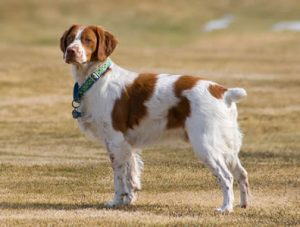
The Brittany is a breed of gun dog bred primarily for bird hunting. Although the Brittany is often referred to as a spaniel, the breed’s working characteristics are more akin to a pointer or setter. Brittanys were developed in the Brittany province of France in the 1800s.
Appearance
A Brittany is typically quite athletic, compact, and solidly built without being heavy. Other characteristics include long legs, and their expressions are usually of intelligence, vigour, and alertness. Their gait is elastic, long, and free.
Some Brittanys are born with naturally short tails and others with long tails. If born with a long tail it is normally docked to a length of 3 to 10 centimetres (1 to 4 inches).
Brittanys come in a variety of colours, where an orange and white coat or liver and white are most common in the American Brittany; other colours include orange roan and liver roan, all of which are acceptable in the show ring. The American Brittany Standard does specify an acceptable tri-colour of liver, orange, and white with very specific colour placement which is also acceptable in the show ring.
Size
Brittanys should range in a height of 17 inches to 20.5 inches at the withers (17.5 to 20.5 in America), with females at the lower end and males taller. A properly constructed and healthy Brittany maintains a weight between 36 and 43 lb (16 to 19 kg), depending upon height. North American field lines tend to be larger, with many dogs reaching a healthy weight of 45 to 50 lb (20 to 23 kg).
Types
Many breeders differentiate between “American” Brittanys and “French” style Brittanys. Although generally recognised as sub-sets of the same breed, there are recognisable differences between the two. The French Brittany appears more “spaniel-like” in that it is smaller and the French Brittany generally works more closely to the guns, but will work according to the local terrain. However, some breeders consider these “differences” to be unsound generalisations and that American standards should be updated to reflect the breed’s standard in its country of origin, i.e. France, where black has become an acceptable coat colour since 1956 while it is still considered a fault in America. Originally known as the Brittany Spaniel, the word “spaniel” was dropped in the U.S. some years ago, as the American Brittany Club persuaded the American Kennel Club to discontinue the use of the term “spaniel” for this breed. When translating the Latin version of the Brittany’s name, it was assumed that spaniel was attached, as the Brittany does resemble a spaniel-like dog. Spaniels, such as Springers and Cockers, are used for flushing game, while Brittanys are more akin to pointers and all-purpose sporting dogs. Known in the United Kingdom as an HPR breed (Hunt, point, and retrieve), they are expected to point and retrieve all birds and ground game up to and including hare.
Temperament
The breed was originally bred as a hunting dog and noted for being easy to train and sweet-natured. The breed is generally more sensitive to correction than other hunting breeds, and harsh corrections are often unnecessary. Brittanys are all around sound dogs, as they are excellent family pets as well as working dogs in the field.
The dogs are active and require frequent exercise and room to run, and a fenced yard is essential. At least one long walk is required daily to satisfy the needs of most Brittanys, and many Brittanys will need more than this. The breed sometimes gets a reputation for being crazy or uncontrollable, but these problems are almost invariably due to lack of exercise and training, and are not commonly seen in well cared-for dogs. If not given sufficient exercise, love, and socialisation, Brittanys can become destructive or develop compulsive or neurotic behaviours. The Brittany makes a good house pet as long as it receives daily mental and physical exercise, as well as superb socialisation on a regular basis.
Brittanys can become very shy if not thoroughly socialised, and even among well-socialised dogs there is significant variation in levels of friendliness. Some are highly gregarious and actively seek companionship, others are more unfriendly.
With more American dual champions (dogs with titles in both conformation shows and field trials) than any other breed, the Brittany maintains strong hunting instincts in all bloodlines.
—————————————————————————————————————–
CARING FOR YOUR DOG NEWSLETTER – Delivered Directly To Your Inbox – Starting Immediately – SIGN UP FOR FREE TODAY
—————————————————————————————————————–
